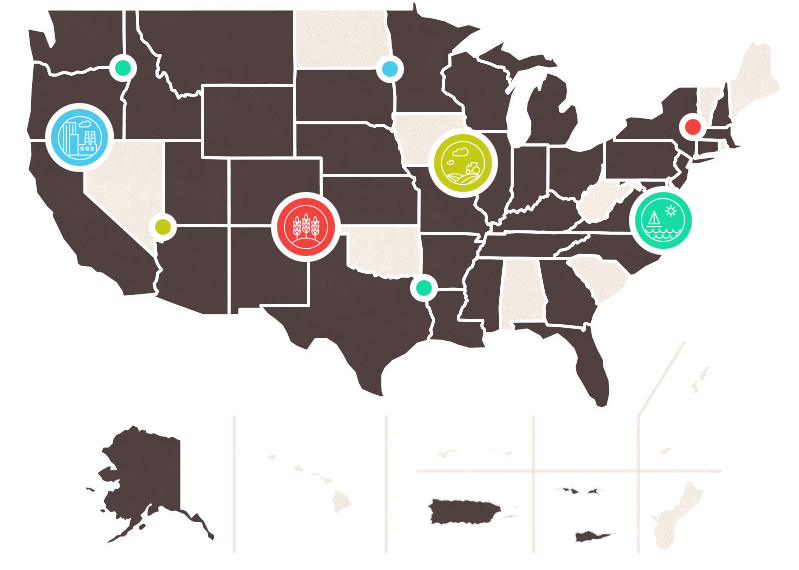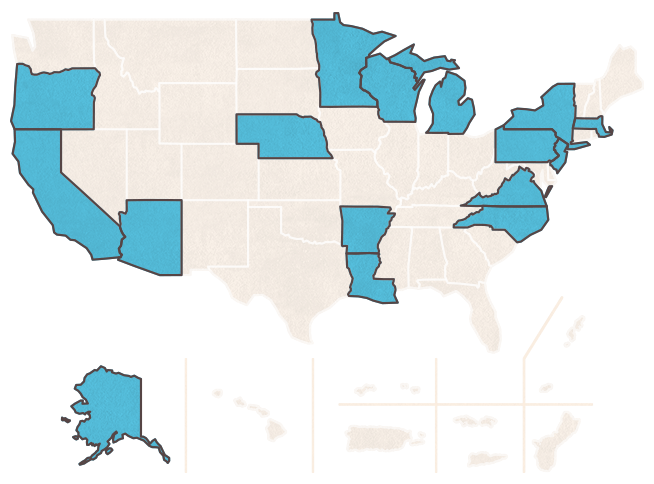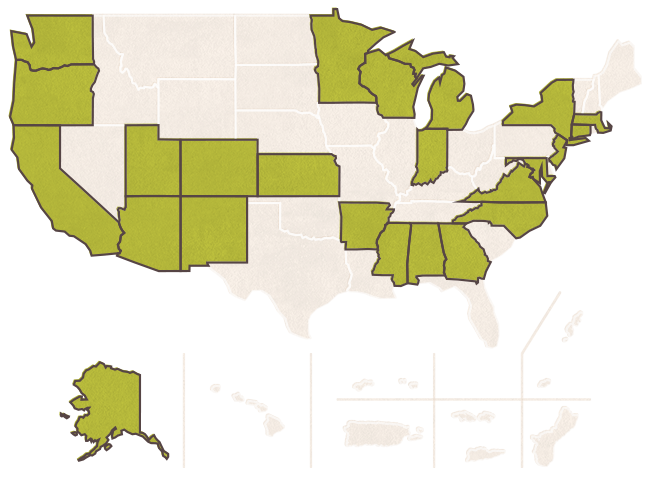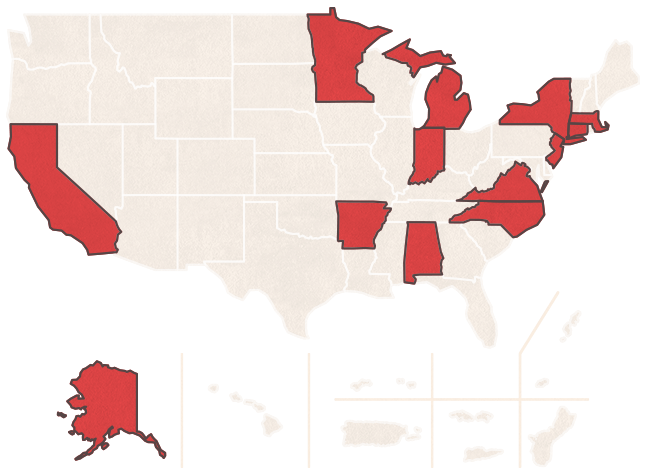2017 ATSDR Annual Report
INVESTIGATING
ENVIRONMENTAL
HAZARDS TO ADVANCE
COMMUNITY HEALTH
ATSDR Improves the Quality of Life in Communities Across America
The Agency for Toxic Substances and Disease Registry (ATSDR) works to protect Americans from the dangerous health effects of toxic substances in the environment. ATSDR responds to requests from federal, state, and local governments to help identify environmental hazards, recommend actions to reduce exposures, and educate the public about how to prevent harmful exposures that can lead to harmful health effects in their communities.

ATSDR Improves the Quality of Life in Communities Across America
The Agency for Toxic Substances and Disease Registry (ATSDR) works to protect Americans from the dangerous health effects of toxic substances in the environment. ATSDR responds to requests from federal, state, and local governments to help identify environmental hazards, recommend actions to reduce exposures, and educate the public about how to prevent harmful exposures that can lead to harmful health effects in their communities.

ATSDR IMPACTS MILLIONS OF LIVES NATIONWIDE
- In 2017 alone, we conducted health activities and investigations in nearly 40 states and territories.
- Nearly 1.2 million people were potentially impacted by exposures at sites where ATSDR worked.
Respond
We collaborate with local, tribal, state, territorial and federal agencies to address environmental emergencies across the country and partnering with communities.
TAKE A LOOK AT WHERE ATSDR WORKED


IN 2017
ATSDR responded to over 500 requests
for assistance across the United States.
IN 2017
ATSDR responded to over 500 requests for assistance across the United States.
State Snapshots
Check out examples of ATSDR’s work across the U.S.
Investigate
ATSDR investigates environmental hazards that have the potential to affect anywhere from a few individuals to more than 100,000 people. Not every ATSDR investigation discovers harmful levels of contaminants. In fact, only about 44% of our investigations in 2017 discovered harmful levels of contaminants (53 out of 121 investigations).
- HOW DOES ATSDR ADDRESS ENVIRONMENTAL HEALTH HAZARDS IN THE COMMUNITIES IT SERVES?
- By identifying environmental exposures and making recommendations for reducing them or their exposure effects.
- WHAT IS A CONTAMINANT?
- A contaminant is a substance that is either present in an environment where it does not belong or is present at levels that might cause harmful (adverse) health effects. The toxicity of a substance depends upon its concentration so even though a potentially toxic substance is present, it does not always mean that the exposure is harmful.
- People come in contact with contaminants through pathways such as water, air, soil, and food.
- For example, while arsenic occurs naturally in air, water, and soil, its presence in the environment can be exacerbated by waste from coal-fired power plants and the mining and smelting of copper, zinc, and lead.
- HOW AM I AT RISK IF EXPOSED?
- Depending upon how much you are exposed to, exposure to a contaminant can lead to increased harmful health outcomes.
- For example, chronic exposure to arsenic can lead to cancers of the skin, lung, and bladder, among other serious health outcomes.
- HOW DOES ATSDR HELP?
- ATSDR works with an affected community to recommend actions to reduce people’s exposure, thereby reducing the risk of health effects in the community and improving the community’s health.
Investigations by Pathway
Click on a pathway to learn about some of the contaminants that may be carried by the pathway and some of the potentially harmful health outcomes that exposure to these contaminants can cause.
Harmful Exposures: WATER
Man-made chemicals and naturally occurring elements and minerals can get into groundwater, surface water, and drinking water in various ways. For example, manufacturing processes or improper disposal of chemicals can lead to them leaching into groundwater or surface water.
ATSDR investigated potential exposures to contaminants carried by water in the following states:

ATSDR CONDUCTED
49
INVESTIGATIONS
ACROSS
20
U.S. STATES and TERRITORIES
AND ASSESSED
425K
PEOPLE for POTENTIAL EXPOSURES
ATSDR CONDUCTED
49
INVESTIGATIONS
ACROSS
20
U.S. STATES and TERRITORIES
AND ASSESSED
425K
PEOPLE for POTENTIAL EXPOSURES
RELATED CONTAMINANTS
- Arsenic
- Manganese
- Man-made chemicals such as PFAS and TCE

HARMFUL HEALTH EFFECTS
- Impaired neurological function
- Cancer
- Decreased ability to get pregnant
- Damage to respiratory and immune systems
- Increased cholesterol
Harmful Exposures: AIR
Individuals can inhale contaminants when they’re released into the air from contaminated sources.
ATSDR investigated potential exposures to contaminants carried by air in the following states:

RELATED CONTAMINANTS
- Heavy metals, incl. cadmium, lead, mercury and arsenic
- TCE

HARMFUL HEALTH EFFECTS
- Respiratory diseases including emphysema and bronchitis
- Liver and kidney damage
- Cancer
Harmful Exposures: SOIL
People may come into contact with contaminants when natural elements found in rocks and fertilizer as well as man-made chemical compounds make their way into the soil. Sometimes contaminants may also naturally occur in soil.
ATSDR investigated potential exposures to contaminants carried by soil in the following states:

RELATED CONTAMINANTS
- Arsenic
- Lead
- PCBs
- Cadmium
- Benzo(a)Pyrene

HARMFUL HEALTH EFFECTS
- Reduce cognitive function in children
- Increase hypertension in adults
- Numbness of the extremities
- Cancers of skin, lung, bladder, and liver
Harmful Exposures: FOOD
Contaminants can accumulate in food sources such as the tissue of animals, fish, fish-eating birds, or contaminated soil where food is grow-fluidn.
ATSDR investigated potential exposures to contaminants carried by food in the following states:

RELATED CONTAMINANTS
- Cadmium
- PCBs
- Dioxins
- Mercury

HARMFUL HEALTH EFFECTS
- Damage to immune and reproductive systems
- Cancer
- Type 2 diabetes
- Heart disease
Protect
ATSDR invests in protecting people and saving lives by ensuring clean air to breathe, water to drink, and food to eat. To accomplish this, we evaluate exposure problems in communities, identify risk factors, develop prevention strategies, and support adoption of these strategies by other federal, state, and/or local agencies, to prevent and reduce exposure to the health threat.
Success Stories

ATSDR Helps Harvey and Maria Survivors Get Much-Needed Disaster Relief
Staff and team members at the Agency for Toxic Substances and Disease Registry have helped Hurricane Harvey and Maria survivors rebuild their lives.

ATSDR Leads Charge to Reduce PFAS Exposure
PFAS are man-made chemicals that have been used in industry and consumer products worldwide since the 1950s. They have been used in non-stick cookware, water-repellent clothing, stain resistant fabrics and carpets, some cosmetics, some firefighting foams, and products that resist grease, water, and oil. Find out how the Agency for Toxic Substances and Disease Registry is helping to identify, respond to, and reduce exposure to these chemicals.

“Our PFAS activities lay an important foundation for future evaluations of PFAS exposure and allow us to effectively respond to needs identified by communities across the country.”
Rachel Worley, PhD
Environmental Health Scientist, ATSDR
“These assessments identified major needs that may not have been otherwise identified.”
CDR Arthur Wendel, MD
U.S. Public Health Service, DCHI
“Our PFAS activities lay an important foundation for future evaluations of PFAS exposure and allow us to effectively respond to needs identified by communities across the country.”
Rachel Worley, PhD
Environmental Health Scientist, ATSDR
“These assessments identified major needs that may not have been otherwise identified.”
CDR Arthur Wendel, MD
U.S. Public Health Service, DCHI
Success by Pathway
Click on a pathway to learn about how we impacted communities across the country.
Contaminated Groundwater in St. Louis
The Missouri Department of Health and Senior Services (MDHSS) and ATSDR took steps to improve safety protocols and well water quality for 12,000 St. Louis residents. In early 2016, a leak from a city treatment plant contaminated well water with toxic organic compounds, posing a serious health risk to people drinking the water. MDH and ATSDR, partnered with the St. Louis Parks to develop a comprehensive remediation plan to protect residents from future contamination. The plan called for enhanced safety protocols, and later, construction of a new treatment plant to serve the affected St. Louis community.

In December 2016, the contaminated well and treatment plant was closed and residents were provided access to uncontaminated, clean water.
Minnesota Employees Exposed to Toxic Air at Work
In 2017, the Minnesota Department of Health (MDH) and Minnesota Pollution Control Agency (MPCA) found potentially harmful trichloroethylene (TCE) vapors at the Balboa Business Center in Mound, Minnesota. TCE is a known human carcinogen that has been linked to leukemia and kidney cancer. Additionally, TCE exposure during the first 2-3 months of pregnancy may increase the risk of heart defects to the baby. Working with the ATSDR, MDH and MPCA informed building management and its occupants of the potential risks to TCE exposure, scheduled calls with occupants to answer questions about TCE and developed a special health advisory for women of childbearing age. Following recommendations from ATSDR, building management also installed 10 air purifiers, sealed cracks, filled drains and adjusted the HVAC.

As a result of these actions, employees at the business center are no longer being exposed to TCE vapors.
ATSDR Recommendations Led to the Removal of Toxic Soil near an Arkansas Neighborhood
Exposure to lead can result in harmful health effects, especially in young children and the unborn babies of pregnant women. Health effects from these exposures can cause learning and behavior problems in young children (children under 6 years old are most at risk as well as unborn children). Recently, the Arkansas Department of Health (ADH), Environmental Protection Agency (EPA), and ATSDR identified exposures to lead-contaminated soil near a neighborhood in Hope, Arkansas. ATSDR’s investigation led to the safe removal of the soil. ATSDR also educated residents about the harmful health effects of lead exposure and provided them with prevention resources.

As a result of these efforts, children and their families are no longer exposed to lead contaminated soils near their homes.
Contaminated Fish in Housatonic River
In 2017, ATSDR teamed up with the Connecticut Department of Public Health (CTDPH) to protect residents from the harmful health effects of polychlorinated biphenyl (PCB) contamination in fish. For the first time in over 20 years, PCB levels in Connecticut’s Housatonic River increased, making certain fish species unsafe for consumption. ATSDR provided recommendations to update an existing statewide warning advisory about the contaminated fish. Updates were posted on social media and distributed to tackle shops, local health departments, and town halls.

With the updates, nearly 160,000 Connecticut residents are better informed about the health risks associated with eating fish caught in the Housatonic River.
Prevent
ATSDR cares for the communities it serves by making long-term investments that lead to sustainable community impacts.
ATSDR enables communities to better protect themselves from environmental threats in the future.
We provide prevention recommendations, health education, and in-state capacity building measures for communities and tribes, along with practical, tangible resources they can use to continue protecting themselves from environmental health hazards in the future.
Impact in Action
In developing the Choose Safe Places for Early Care and Education (ECE) program, ATSDR:
- Encourages those interested in establishing an ECE program, as well as state and local agencies that support ECE programs to consider environmental conditions when choosing locations for ECE facilities.
- Gives towns, cities, and states a framework to adopt practices from unknowingly creating situations where children are exposed to chemical hazards.
- Enables partner communities to:
- Learn how they can protect children where they learn and play
- Learn about important existing environmental health guidance from governmental and nongovernmental organizations

IN 2017,
ATSDR recommendations were adopted by health agencies
in numerous communities nationwide, which led to the elimination
of harmful environmental hazards and protected
nearly 100,000 people.
IN 2017,
ATSDR recommendations were adopted by health agencies in numerous communities nationwide, which led to the elimination of harmful environmental hazards and protected nearly 100,000 people.
Summary
In responding to concerns about the effect toxic substances have on at-risk populations, ATSDR successfully:

Addresses issues found in air, water, soil, and food pathways.

Customizes recommendations that can improve health in a specific community.

Increases awareness of environmental issues affecting public health.

Empowers residents to keep their communities safe from future exposures to environmental hazards.








